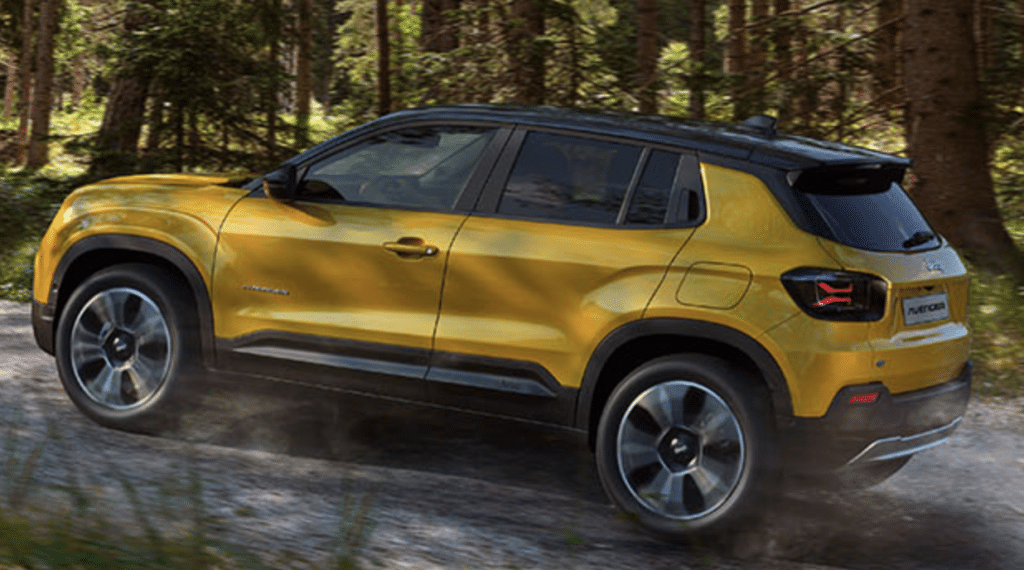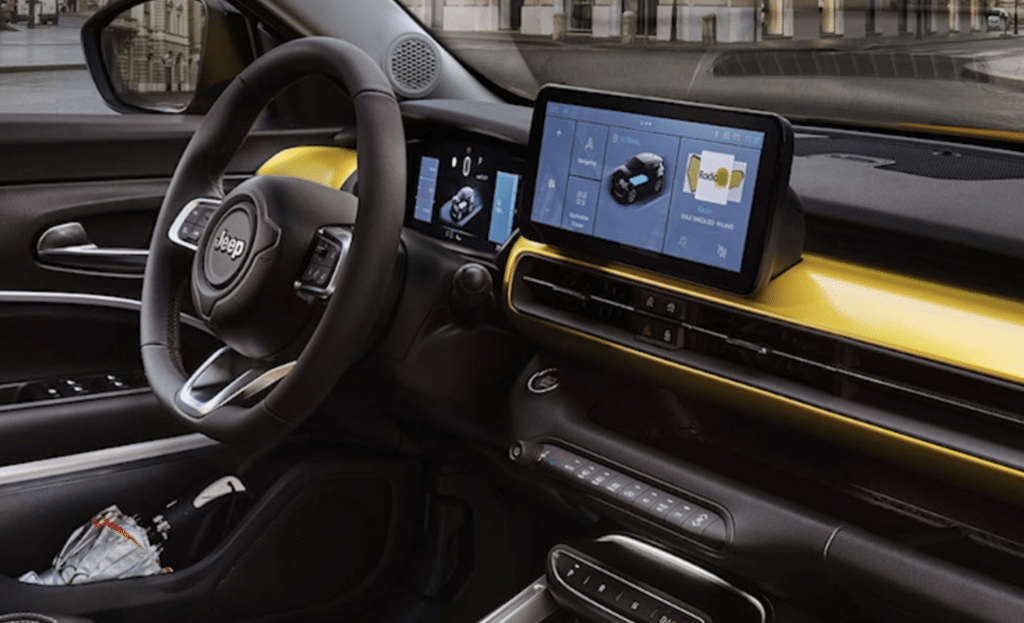Overview – Jeep Avenger Electric
The Jeep Avenger is a battery-electric vehicle with a long history of various brands within the Chrysler empire.
The Avenger is a surprisingly small electric Jeep, 6 inches shorter than Jeep’s own Renegade or almost all the other crossovers. The body is based on the Stellantis Group’s eCMP 2 platform.

It has the potential to rival Toyota’s Yaris Cross or Nissan’s Juke Hybrid in economy and Ford’s Puma and Renault’s 4 in more conventional petrol forms. Its design has a lot of current and past Jeep cues, as well as protective body features. It has excellent off-road credentials and is able to fit perfectly into urban life.
It is the first electric model by Jeep, and it is available in the U.K. next summer priced from about £34,000.
Jeep Avenger Electric – Energy And Carbon Efficiency
As befitting its smaller footprint, the Jeep Avenger Electric has pretty low carbon emissions compared to others in the EV class, emitting 81 gCO2/mi (50 gCO2/km). This is significantly lower than the Ford Mustang Mach-E SR AWD (108 gCO2/mi or 68 gCO2/km), BMW i7 xDrive60 (104 gCO2/mi), Jaguar I-Pace EV400 (112 gCO2/mi), and is slightly lower than the Volkswagen ID5 (92 gCO2/mi) and Hyundai IONIQ 6 (84 gCO2/mi). These figures demonstrate the Jeep’s commitment to creating a more sustainable and environmentally-friendly vehicle.
EV Engine, Power and Performance
The Avenger has a 52 kWh lithium-ion battery with 102 cells and 156bhp motor, with a WLTP range of 241-255 miles depending on the wheel size. It is quick and quiet, and is able to go beyond the city limits. It has a tessellated battery design in order to fit the petrol version in some countries, while still leaving the footwells clear.
It is a front-drive model, with a 184 pound-feet of torque to the front wheels. It has a maximum 100-kilowatt fast charging rate and an 11kW onboard charger, with charge times ranging from 24 minutes on a 100kW DC fast charger to eight hours on a 7.4kW home wall box. It has three driving modes, which alter the motor output, and upper-trim models have hill descent control. Performance is brisk for Europe, with a 0-62 mph time of 9 seconds.
Interior Comfort and Cargo Dimensions
The Avenger is surprisingly roomy for its size and has plenty of legroom. It has flat slab batteries and a battery layout that can be tessellated into the spaces where the exhaust, fuel tank and other components would be located.
The cabin is compact and intimate, with head- and legroom to spare in the rear. It has two levels of cargo area floor, allowing for either a fully flat load floor or maximum capacity. The cargo area is 39.4 inches wide and is quite high off the ground. The seats are manually adjusted, and the switches are sensitive and easily identified.
Infotainment, Tech and Connectivity
All models feature two 10.25-inch panels for the Uconnect infotainment system, complete with Apple CarPlay and Android Auto. That’s paired with a seven-inch digital driver’s display in lower-spec cars, or a larger 10.25-unit in the pricier versions. The dashboard design is neat and simple, but also functional, thanks to the use of physical buttons for the drive-selector and climate controls.
Unsually it has an indicator repeater that sounds like a frog trapped in a box. It has a thermally efficient heat pump heating system and a sophisticated braking-based traction control system.
It has Level 2 Autonomous Driving capability, a wireless charging pad, a hands-free power tailgate, adaptive cruise control, lane centering, and traffic jam assist.
Level 2 Autonomous Driving is a type of driving that combines both human and machine control. It is a step up from Level 1 driving, which only uses driver assistance technology, as Level 2 Autonomous Driving uses automated systems to control the speed, steering, and lane positioning of the vehicle. It requires the driver to remain alert and take control of the vehicle when necessary.

Safety Features
The Avenger has a redesigned crash structure at the nose and tail, with bigger-diameter tires and more wheel travel. It also has widened tailgate aperture for easier loading.
The Avenger has electronic stability systems and the accelerator action is altered according to the driving modes. It also has a Jeep-reckoned ability to save up to $1,200 in paint and dent repairs during its life.
The Avenger includes standard safety features such as all-round parking sensors, lane centering, traffic jam assist.
Warranty Information
The Jeep Warranty covers a comprehensive service for 24 months, with a further 12 months Retailers Warranty, starting from the vehicle’s first registration date. It also covers body perforation due to corrosion from the inside out for 7 years and manufacturing defects concerning the paint for 36 months. It includes roadside assistance, original parts, certified technicians, car body, paint, parts and labor.
Final Thoughts – Jeep Avenger Electric
The Avenger is an excellent city car, with good range and rapid charging capabilities and ideal for suburban families. It is smooth and locally emissions-free. It is small and manoeuvrable and it can handle moderate off-road trails. It is also chuckable in corners, thanks to its small size and long-travel suspension.
The Jeep Avenger is a likable and fun-to-drive car with a practical and comfortable cabin. Despite its impressive features, it is not coming to the United States.
Technical Specifications
Basic Information
| Make | Jeep |
| Model | Avenger Electric |
| Car Body | SUV |
| Number Of Seats | 5 |
Estimated Energy Efficiency
| Efficiency (mi/kWh) | 4.8 mi/kWh |
| Efficiency (km/kWh) | 7.7 km/kWh |
Engine
| Horsepower | 153 HP (156 PS) |
| Acceleration 0-100 km/h | 9 seconds |
| Towing Weight | 0 lbs (0 kg) |
Charging
| Charge Port | Type 2 |
| Charge Time | 5h30m |
| Fast Charge Power Max | 100kW DC |
| Fast Charge Time | 26 min |
Safety
| Adult Safety Rating | none |
| Child Safety Rating | none |
Purchasing
| Available Countries | UK,Netherlands,Germany |
| Date Of Availability | January 2023 |
| Estimated Price | £36,500 |
Estimated Carbon Efficiency (Grid/Country Dependent)
| USA | 81 gCO2/mi (50 gCO2/km) |
| Iceland | 7 gCO2/mi (4 gCO2/km) |
| Canada | 18 gCO2/mi (18 gCO2/km) |
| France | 22 gCO2/mi (14 gCO2/km) |
| Efficient Gas Car | 272 g CO2/mi (170 g CO2/km) |
Battery
| Size (kWh) | 50.8 kWh |
| Voltage (V) | 377 V |
Range
| WLTP Range (km) | 390 |
Dimensions
| Car Length | 161 inches (4084 mm) |
| Car Width | 70 inches (1776 mm) |
| Car Height | 60 inches (1528 mm) |
| Cargo (Trunk or Boot) Volume | 13 cu ft (355 L) |
| Frunk Volume | 0 cu ft (0 L) |
